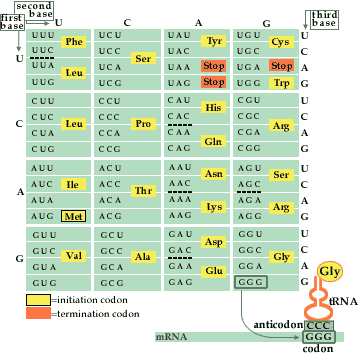The Genetic Code
The genetic information in the
mRNA is composed of an alternating sequence of the
four bases adenine (A), guanine (G), cytosine (C) and
uracil (U). This alternating sequence provides the
unique code specifying each of the 20 amino acids
naturally found in protein.
20 amino
acids»
It was early realised that the
only way codons for the 20 amino acids could be
spelled out from the four available nucleotides was
to use combinations of at least three bases, codons
(43 = 64 combinations). In the beginning
of the 1960s, the nature of the genetic code was
experimentally tested using artificial mRNAs composed
of only one base (homopolymers), or a composition of
synthetic trinucleotides representing all 64 possible
codon combinations. Using these techniques the
genetic code was solved and the main contributors,
Nirenberg and Khorana, were awarded the 1968 Nobel
Prize in Physiology or Medicine.
 |
|
In the genetic code each of the 20 amino acids is
represented by at least one codon. Most of the amino
acids are coded for by more than one codon. This is
referred to as the degeneracy of the code.
The code has no comma (i.e. unlike written language
there are no separators between words). After
identification of the first codon, translation
proceeds by taking the following nucleotides three at
a time.
The genetic code is read by transfer RNAs (tRNA). Each tRNA has
an anticodon that is complementary to the codon in
the mRNA (see basepairing
principles). However, due to the so-called wobble principle the cell
manages with less tRNAs than would be expected from
the number of anticodons required to match the codons
in the code table. Each tRNA can also carry the amino
acid specified by the codon (see amino acid
activation).
Three of the codons do not code for any amino acid.
These codons are instead interpreted as stop signals
i.e. signals that define the end of the message (see
termination). It is
notable that there is no unique codon specifying the
point were the message starts. Instead the codon
coding for the amino acid methionine, AUG, has two
functions: it can either specify incorporation of
methionine into the growing protein chain (see
elongation) or specify
the starting point of the message (see initiation). The discrimination
between the two functions of the AUG codon is coupled
to the occurrence of two structurally different
methionine-carrying tRNAs (Met-tRNAs), elongator
Met-tRNAm and initiator Met-tRNAi.
|
